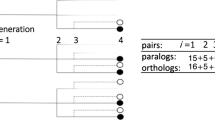Abstract
We derive the mixture of distributions of sequence similarity for duplicate gene pairs generated by repeated episodes of whole genome doubling. This involves integrating sequence divergence and gene pair loss through fractionation, using a birth-and-death process and a mutational model. We account not only for the timing of these events in terms of local modes, but also the amplitude and variance of the component distributions. This model is then extended to orthologous gene pairs, applied to the evolution of the Solanaceae, focusing on the genomes of economically important crops. We assess how consistent or variable fractionation is from species to species and over time.
Access this chapter
Tax calculation will be finalised at checkout
Purchases are for personal use only
Similar content being viewed by others
References
Zhang, Y., Zheng, C., Sankoff, D.: Evolutionary model for the statistical divergence of paralogous and orthologous gene pairs generated by whole genome duplication and speciation. IEEE/ACM Trans. Comput. Biol. Bioinf. 1545–5963 (2017)
Zhang, Y., Zheng, C., Sankoff, D.: Pinning down ploidy in paleopolyploid plants. BMC Genomics 19(Suppl 5), 287 (2018)
Sankoff, D., Zheng, C., Zhang, Y., Meidanis, J., Lyons, E., Tang, H.: Models for similarity distributions of syntenic homologs and applications to phylogenomics. IEEE/ACM Trans. Comput. Biol. Bioinf. (2018). https://doi.org/10.1109/TCBB.2018.2849377
Lyons, E., Freeling, M.: How to usefully compare homologous plant genes and chromosomes as DNA sequences. Plant J. 53, 661–673 (2008)
Lyons, E., Pedersen, B., Kane, J., Freeling, M.: The value of non-model genomes and an example using SynMap within CoGe to dissect the hexaploidy that predates rosids. Trop. Plant Biol. 1, 181–190 (2008)
McLachlan, G.J., Peel, D., Basford, K.E., Adams, P.: The Emmix software for the fitting of mixtures of normal and t-components. J. Stat. Softw. 4, 1–14 (1999)
Sankoff, D.: Duration of detectible synchrony in a binary branching process. Biometrika 58, 77–81 (1971)
Vallée, G.C., Santos Muńoz, D., Sankoff, D.: Economic importance, taxonomic representation and scientific priority as drivers of genome sequencing projects. BMC Genomics 17, (Suppl 10), 782 (2016)
The Tomato Genome Consortium: The tomato genome sequence provides insights into fleshy fruit evolution. Nature 485, 635–641 (2012)
The Potato Genome Sequencing Consortium: Genome sequence and analysis of the tuber crop potato. Nature 475, 189–195 (2011). DNA Research 21, 649–C660 (2014)
Kim, S., Park, M., Yeom, S.I., Kim, Y.M., Lee, J.M.: Genome sequence of the hot pepper provides insights into the evolution of pungency in Capsicum species. Nature Genet. 46, 270–278 (2014)
Bombarely, A., Rosli, H.G., Vrebalov, J., Moffett, P., Mueller, L.A., Martin, G.B.: A draft genome sequence of Nicotiana benthamiana to enhance molecular plant-microbe biology research. Mol. Plant-Microbe Interact. 25, 1523–1530 (2012)
Bombarely, A., Moser, M., Amrad, A., Bao, M., et al.: Insight into the evolution of the Solanaceae from the parental genomes of Petunia hybrida. Nature Plants 2 (16074) (2016)
Hirakawa, H., Shirasawa, K., Miyatake, K., Nunome, T., Negoro, S., et al.: Draft genome sequence of eggplant (Solanum melongena L.): the representative Solanum species indigenous to the Old World. DNA Research 21, 649–60 (2014)
Jaillon, O., Aury, J.M., Noel, B., Policriti, A., Clepet, C., et al.: The grapevine genome sequence suggests ancestral hexaploidization in major angiosperm phyla. Nature 449, 463–467 (2007)
Zheng, C., Chen, E., Albert, V.A., Lyons, E., Sankoff, D.: Ancient eudicot hexaploidy meets ancestral eurosid gene order. BMC Genomics 14, S7:S3 (2013)
Sankoff, D., Zheng, C., Zhu, Q.: The collapse of gene complement following whole genome duplication. BMC Genomics 11, 313 (2010)
Acknowledgements
Research supported in part by grants from the Natural Sciences and Engineering Research Council of Canada. DS holds the Canada Research Chair in Mathematical Genomics.
Author information
Authors and Affiliations
Corresponding author
Editor information
Editors and Affiliations
Rights and permissions
Copyright information
© 2018 Springer Nature Switzerland AG
About this paper
Cite this paper
Zhang, Y., Zheng, C., Sankoff, D. (2018). Speciation and Rate Variation in a Birth-and-Death Account of WGD and Fractionation; the Case of Solanaceae. In: Blanchette, M., Ouangraoua, A. (eds) Comparative Genomics. RECOMB-CG 2018. Lecture Notes in Computer Science(), vol 11183. Springer, Cham. https://doi.org/10.1007/978-3-030-00834-5_8
Download citation
DOI: https://doi.org/10.1007/978-3-030-00834-5_8
Published:
Publisher Name: Springer, Cham
Print ISBN: 978-3-030-00833-8
Online ISBN: 978-3-030-00834-5
eBook Packages: Computer ScienceComputer Science (R0)




